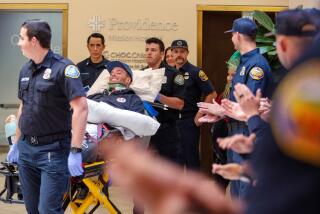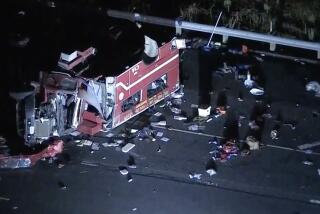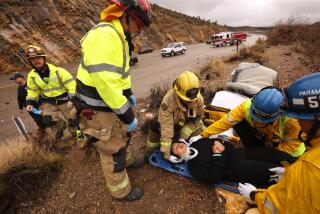Firefighters’ Class Creates Fast-Response Paramedics
Twenty-seven firefighters graduated from a paramedic training class Monday as part of a San Diego program designed to get to medical emergencies more quickly.
The experimental program was created to determine whether the quality of on-site care is improved as a result of having firefighters trained as paramedics.
The program is based on the premise that firefighters, who almost always arrive at a medical emergency before paramedics but with relatively little medical training, can provide immediate help, said Tom Morgan, president of Hartson Medical Services.
Firefighters have an average response time of four to five minutes, and a Hartson ambulance arrives in about six minutes, he said.
Hartson ambulances, which are under contract to the city and are staffed by company paramedics, will continue to transport people to hospitals.
At first, there will be more paramedic firefighters in both the northern and southern parts of the city, which have more fire stations than Hartson units, Morgan said.
“A lot of cities have gone to this system, of paramedic firefighters being at the scene first and treating people, and then paramedics arriving, but no one has ever proved this is better for patient care,” Morgan said.
The program, which will began Oct. 1 and end late in March, will gather data about whether firefighters, with their faster response times and their increased medical training, make a significant difference, Morgan said.
The 27 who graduated Monday will become certified paramedics in early September if they pass a written test given by the state, said San Diego Fire Department Chief Jerry Cannon said.
They, along with 11 firefighters who are already certified, will be added to eight fire stations in the northern part of the city and three in the South Bay. The program will supply every fire engine in the north and South Bay with one firefighter trained as a paramedic, Cannon said.
Traditionally, firefighters have been trained as emergency medical technicians, with much less training than paramedics, Cannon said.
In some situations, extra minutes can be crucial, said firefighter Dan Goebel. “For instance, a brain will cease to work in six to 10 minutes if it’s not getting oxygen,” he said.
Emergency medical technicians have only 100 hours of training and can provide basic life support, Cannon said. For example, they can give oxygen, but, if the airway is closed, they are not trained and do not have the right equipment to open it, Cannon explained.
In contrast, paramedics, who receive more than 1,000 hours of training, can provide advanced life support and would be able to open the airway, Cannon said.
Everyone who is in the program volunteered, Cannon said. During an eight-month training program given by the UC San Diego Emergency Medical Service Training Institute, firefighters received more than 300 hours of classroom training, about 200 hours of training in hospitals and clinics and about 500 hours of field work.
The class was tough, especially because everyone who was in the class also was working also full-time, said firefighter Margo Johnson, who graduated Monday.
“Depending on if you were at a busy station or not, if you were up all night, then you might have three tests the next morning,” Johnson said.
“Firefighters as a group are pretty stubborn,” she said, “so no one’s going to be the first to say anything.”
More to Read
Sign up for Essential California
The most important California stories and recommendations in your inbox every morning.
You may occasionally receive promotional content from the Los Angeles Times.










